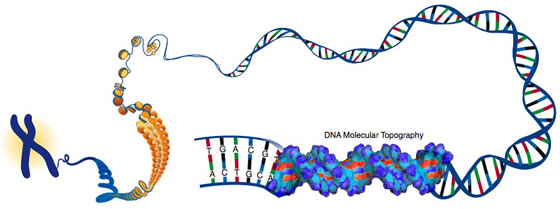DNA or deoxyribonucleic acid is the basic hereditary material present in all the cells of an organism and basically provides a blue print for the cell’s functions, growth, reproduction and death. The structure of the DNA called the double-stranded helical structure was first described by Watson and Crick in 1953.
From then enormous progress has been made in synthesis, sequencing, and manipulation of DNA. The DNA these days can be sequenced or analysed for minute details and even genes may be inserted to cause changes in the DNA function and structure.

This illustration depicts DNA packed tightly into chromosomes, as well as a DNA molecule unwound to reveal its 3-D structure. Credit: Darryl Leja, NHGRI
Structure of DNA
The DNA is a polymer molecule with four types of basic chemicals. These are called the deoxyribonucleotides. They contain:
- a sugar (deoxyribose)
- a negatively charged phosphate group
- the bases:
- adenine (A)
- cytosine (C)
- guanine (G)
- thymine (T)
The nucleotides are linked together by covalent phosphodiester bonds.
Double stranded helix
When looking at the structure, Watson and Crick found that DNA is a double stranded helix or a ladder that is twisted. Here the bases form the rungs of the ladder and the sugar phosphates are on the outside.
There are hydrogen bonds between a large purine base (A or G) on one strand and a small pyrimidine base (T or C) on the other chain. The base-pair sequence is usually referred to as the primary structure of DNA. This sequence determines the actual structure of the DNA.
Why is DNA important?
DNA carries the genetic code and this is what is read by the protein synthesis mechanism when it makes new proteins.
The relationship between DNA and proteins is vital for living organisms. A protein is an abundant and complex molecule found in the body. These may be important for forming the body structure (Structural proteins), messengers, enzymes, hormones etc.
Shape and handedness of DNA
DNA can have a variety of shapes and lengths. Under physiological conditions DNA is found in the so-called B-form, a right-handed double-stranded helix. There is a repeat twist or helix after every 10.4 base pairs or around 34nanometers. The thickness of the DNA is about 2nm and a base pair thickness is about 0.34nm.
DNA Grooves
As the DNA strands are twisted they have distinct grooves. DNA has two kinds of grooves that play important roles in its functioning. Major and minor grooves help in formation of different proteins. These grooves bind proteins like transcription factors that lead to formation of the proteins.
Conformations of DNA
DNA can be present in several different conformations and these are important for DNA functions and actions. Conformations of DNA are vital for the repair of damaged DNA because they act with the enzymes in the body.
DNA Supercoiling
The DNA strands are like a phone cable or a rope. This coiling is a central property of DNA. DNA can be in a relaxed or a coiled state. Coiling helps the extremely long DNA strands to fit into the tiny cell nucleus. Put simply, this supercoiling property makes DNA more efficient packing in more information in small spaces.
What is DNA Sense and Antisense?
RNA or ribonucleic acid is a cousin of DNA. DNA actually codes for RNA and holds the codes for the amino acids that are building blocks for proteins.
The antisense strand is the DNA strand that carries important information to make proteins. This antisense strand is the key for making proteins. The sense strand is the other strand that does not code for RNA.
Sources
- https://www2.mpip-mainz.mpg.de/
- http://www.exploredna.co.uk/learn-about-dna-structure.html
- http://mbb.rutgers.edu/315-NP/315-Ch1Basics.pdf
- https://www.cliffsnotes.com/
- http://biology.kenyon.edu/courses/biol63/watson_06.pdf
- https://cmgm-new.stanford.edu/
Further Reading